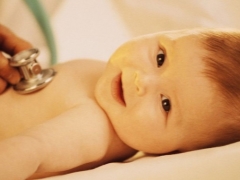Nuclear jaundice of newborns
Neonatal jaundice occurs in every second full-term newborn infant, and if the baby was born prematurely, then this condition appears in 70-85% of cases. Such jaundice is often physiological, so most babies pass it on their own. However, in some babies, it requires treatment, as the risk of nuclear jaundice increases.
What is it?
So called a complication in which the level of bilirubin in the blood of the infant is so high that the pigment begins to penetrate into the brain cells. The name of this jaundice is due to a lesion of bilirubin subcortical nuclei in the brain. The further state of the crumbs in this case will depend on the speed of diagnosis and therapeutic measures.
Nowadays, nuclear jaundice is quite rare, since newborns with elevated bilirubin are under constant supervision by medical staff, and blood tests promptly suggest when to resort to using phototherapy, infusion therapy, and other treatments.
Symptoms and signs
When nuclear jaundice only begins to develop, it manifests itself:
- Yellow skin tone.
- Worsened appetite (baby refuses breast).
- Lethargy
- Increased body temperature.
- Drowsiness.
- Flexing the body of the baby.
- Tilting the head of a child.
- Hypotension.
- An increase in the size of the liver, as well as the spleen.
At the late stage, the main manifestations of nuclear jaundice are:
- Loud monotonous cry.
- Muscle cramps.
- Occasionally vomiting.
- Muscle tension in the neck.
- Apnea.
A baby who has had nuclear jaundice may have problems with hearing, tooth enamel, mental development. Also, the consequence of such jaundice is paralysis.
Treatment
An infant with a high risk of nuclear jaundice or with its first manifestations is prescribed:
- Phototherapy The child is kept under special UV lamps, the light of which converts toxic bilirubin to a harmless isomer. The procedure can cause overheating and dehydration, so it is important for the baby to additionally give or inject liquid during such a phototherapy.
- Blood transfusion in a serious condition of the baby.
- Infusion therapy in which saline solutions and 10% glucose are infused into the baby.
- Medications that promote the more rapid removal of bilirubin from the body of an infant (drugs with choleretic action).
- Enterosorbents, under the action of which the bilirubin will not be absorbed back during the advancement of the feces through the intestines.
- Supplement with 5% glucose to improve liver function and energy support.
Tips
- To bilirubin quickly left the body of the newborn, it is important for the crumb to be often applied to the chest, without making night breaks. It is especially important that the baby receives colostrum.
- A child at risk of developing nuclear jaundice must be constantly under medical supervision. In this case, the mother also needs to monitor the baby and immediately consult a doctor if she noticed the warning signs.
- The child will regularly do a blood test from a vein to find out the level of bilirubin and its hourly increase. Blood is taken from the veins on the head or on the arm, but it’s not worth worrying that such manipulations hurt the baby. Typically, such procedures are performed by experienced nurses, using syringes with thin needles.













